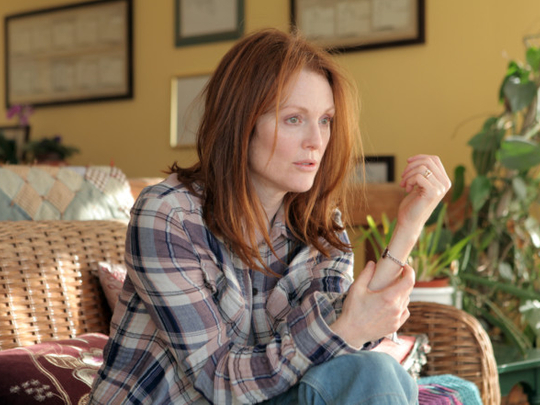
If you see Still Alice in the theatre, be prepared to sit through the closing credits. You’ll need that time to compose yourself before walking into the harsh light, where people may be inclined to ask you why your eyes are red.
The drama is designed to make you cry. And it succeeds, even if the methods applied by directors Wash Westmoreland and Richard Glatzer (who adapted Lisa Genova’s novel for the screen) are obvious.
You’ve no doubt already heard about the Alice of the movie’s title. She’s played by Julianne Moore, who took home a well-deserved Golden Globe for her performance as a renowned linguistics professor afflicted with a very rare form of Alzheimer’s that’s both early onset and genetically passed.
Alice is barely 50, and already the symptoms are impossible to ignore. She gets lost on a jog around Columbia University, where she works; she introduces and reintroduces herself to people in short order; and words, which have been Alice’s life, are becoming increasingly elusive.
This is all horrifying to watch, and the inevitability of Alice’s fate doesn’t soften the blow. But for all the bleakness in Still Alice, the movie never loses its lustre. Alice is essentially the heroine of a Nancy Meyers movie: Her anguish far exceeds the midlife heartache of the protagonists in It’s Complicated and Something’s Gotta Give. But there’s still something so tidy about Alice’s existence — her perfect kitchen, healthful home-cooked meals, three loving kids, passionate marriage, dazzling career.
Alice is married to John, a doctor, played by Alec Baldwin, and the pair have two daughters and a son, all of whom are doing fairly well in the scheme of things, although the youngest, Lydia, is struggling to make it as an actor in Los Angeles.
John has workaholic tendencies and Lydia (Kristen Stewart) may live in a group house (the horror!), but these attempts to make Alice’s pre-Alzheimer’s life seem like anything but fiction fail. Instead, the setup looks like a woman’s wildest dream of “having it all,” and with a beach house to boot.
It’s a credit to Moore that none of this blunts the movie’s poignancy. Alice’s situation feels false, but the actress is ferociously authentic. And the directors are smart to keep a tight focus on Moore.
During Alice’s ill-fated jog, the camera circles around her alarmed face, leaving everything else a blur and amping up the sound of her terrified panting. When Alice first visits a neurologist, we only see Moore, even as the doctor asks her questions. We get to know Alice during these scenes. She’s intelligent and polite, even as she clearly thinks the doctor’s queries are inane. (She’s convinced she has a brain tumour.)
When the reality of her situation begins to set in, Alice’s fear and anxiety turn, at times, to hysteria. In other hands, these moments could veer into melodrama, but Moore earns the audience’s empathy. Her glossy circumstances disappear into the background, and all we see is an ailing woman, overwhelmed by her fate.
It’s noteworthy that Westmoreland and Glatzer, who are married, decided to make the movie after Glatzer was diagnosed with ALS, another awful, incurable degenerative disease. Maybe Still Alice was an attempt for a cathartic outlet, a way to express so many painful emotions while also staying busy. But it also explains why the movie is never as raw as it might have been. The filmmakers invite the audience to get close enough to feel the pain without having to relive the depths of the real-life horror.






